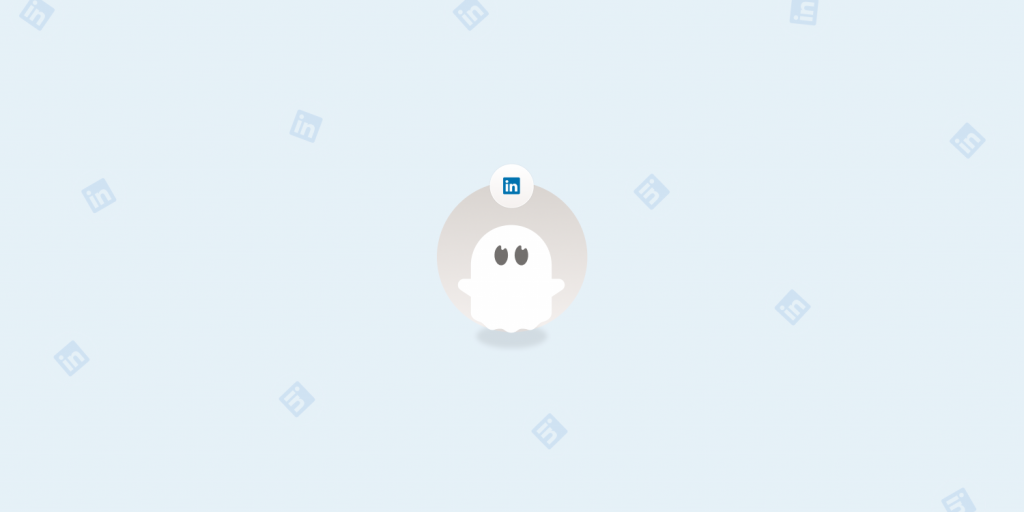Want to get started with LinkedIn prospecting? Good call! With 1 billion active users, decision-makers, and potential customers, LinkedIn is the ultimate professional network for you to tap into.
In this guide, you'll get access to the best LinkedIn prospecting tools and best practices.
You'll then be able to find the right people, get to know them better and scale your LinkedIn lead generation.
TL;DR
-
You don't necessarily need a Sales Navigator account for LinkedIn prospecting, but its advanced features could make a difference.
-
How to find potential leads: Source profiles from groups, events, and post commenters, as these people will already be interested in your niche. Plus, use the LinkedIn search engine to find other relevant profiles.
-
How to enrich your leads: Use profile scraping, artificial intelligence, and CRM data workflows to better understand your leads. This will make your outreach campaigns more personalized and effective.
-
How to automate your lead generation: Use filters and personalization tags to make your automated messages sound natural, and try to auto-engage with people's posts beforehand. Make the most of Open Profiles and multiple LinkedIn accounts to increase your impact.
-
The best LinkedIn prospecting tools: PhantomBuster is an all-around LinkedIn prospecting tool with a competitive pricing model and pre-built automations, but you can also try out Expandi, Captain Data, and Dux-Soup.
Do you need a LinkedIn Sales Navigator account for prospecting on LinkedIn?
No, you do not need a paid account for LinkedIn prospecting. You can think of LinkedIn Sales Navigator as a "nice to have" feature—but not a "must".
While a LinkedIn Sales Navigator account offers more advanced features, such as InMails and unlimited people browsing, you can already level up your prospecting efforts with a free LinkedIn account.
In this guide, you'll get some actionable strategies that work for either free or paid LinkedIn accounts.
LinkedIn prospecting best practices for finding potential leads
Unlike other social media platforms, LinkedIn lets you filter and source new customers in extraordinary detail.
Here are the 7 best LinkedIn prospecting tips to find more leads in less time.
-
View similar users from a LinkedIn profile
-
Find qualified leads from LinkedIn Groups
-
Use LinkedIn Events to find potential customers
-
Connect with LinkedIn post commenters
-
Focus outreach campaigns on your competitors' followers
-
Make the most of alumni search results
-
Use Sales Navigator's advanced search filters
Find relevant leads from the 'People Also Viewed' section
Why does this work? By focusing on similar profiles to your top leads, you can zoom in on the people who are most likely to be interested in your sales pitch.
When you visit a prospect's LinkedIn profile, you can also view similar users on the right-hand tab. This lets you find other relevant prospects' profiles—and stick to your ideal customer profile (ICP) as you go.
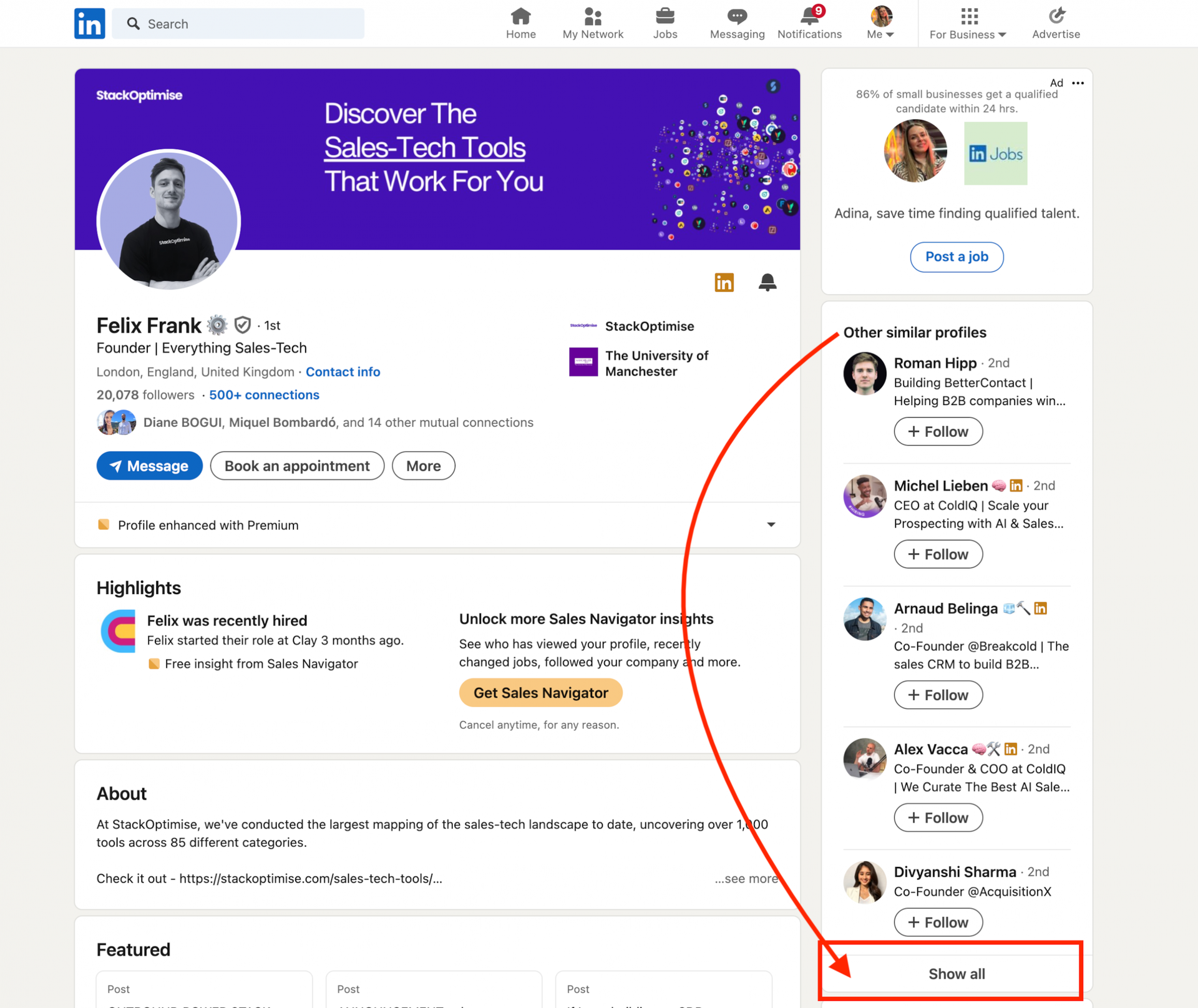
For example, you could identify your best potential customers or decision-makers and then check for similar LinkedIn profiles via their page.
To view all these LinkedIn users at once, click on "Show all", and then browse through the list of profiles.
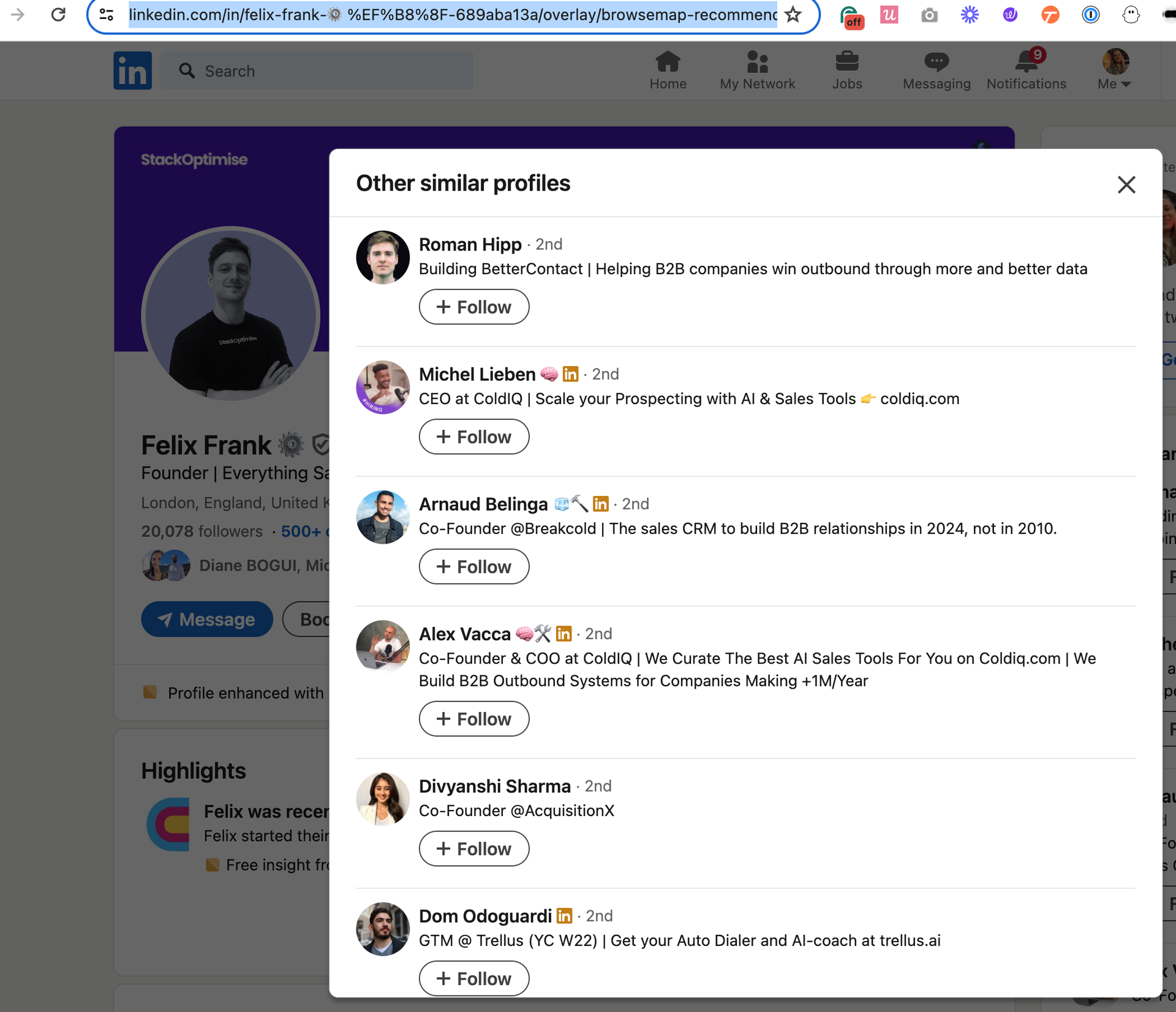
Build a list of qualified leads from relevant LinkedIn Groups
Why does this work? By targeting relevant LinkedIn Groups, you can save time and focus your outreach efforts on communities that match your industry.
Like anyone else, your outreach and prospecting activities are focused on a specific niche.
So, where better to start than with LinkedIn group members?
You'll get instant access to a pool of people who are already chatting about your industry and who will (hopefully) be interested in what you have to say.

Plus, with the right LinkedIn prospecting tool, you can export a whole list of members from LinkedIn Groups, rather than manually copying them.
For example, with PhantomBuster's LinkedIn Group Members Export Phantom, you can share the URL of a group and then download a list of all its members.
(Just make sure you're a member, first!)
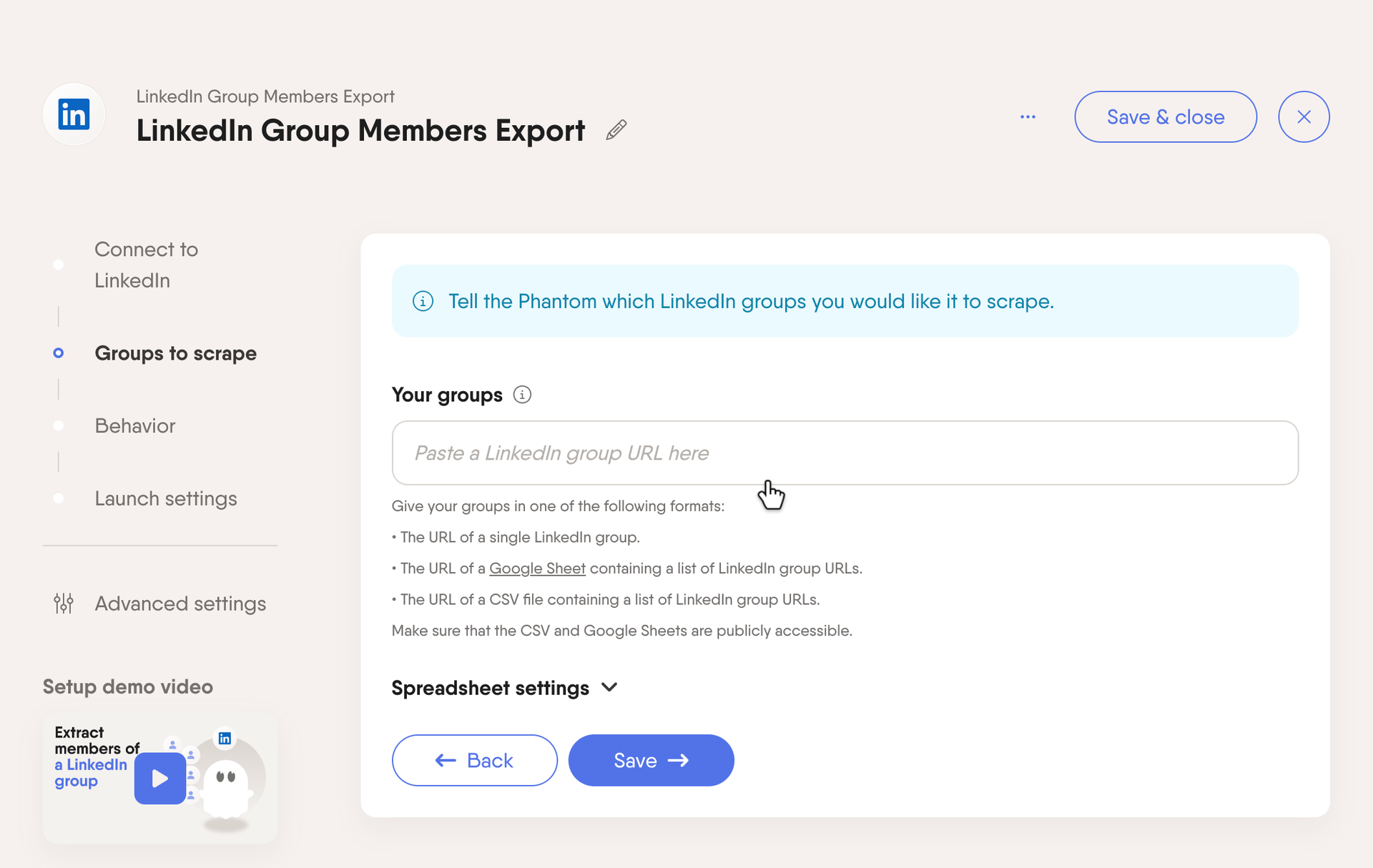
Extract the list of attendees of a LinkedIn Event you attended
Why does this work? People who sign up for a specific LinkedIn Event are typically motivated and highly interested in the topic, making them ideal leads for your sales process.
Similarly, LinkedIn Events are hotspots for fostering professional relationships. Rather than casting your net too wide, you can generate leads based on who's attended a specific event.
If you're joining an event, you can copy the URL and use LinkedIn automation tools to export the list of attendees.
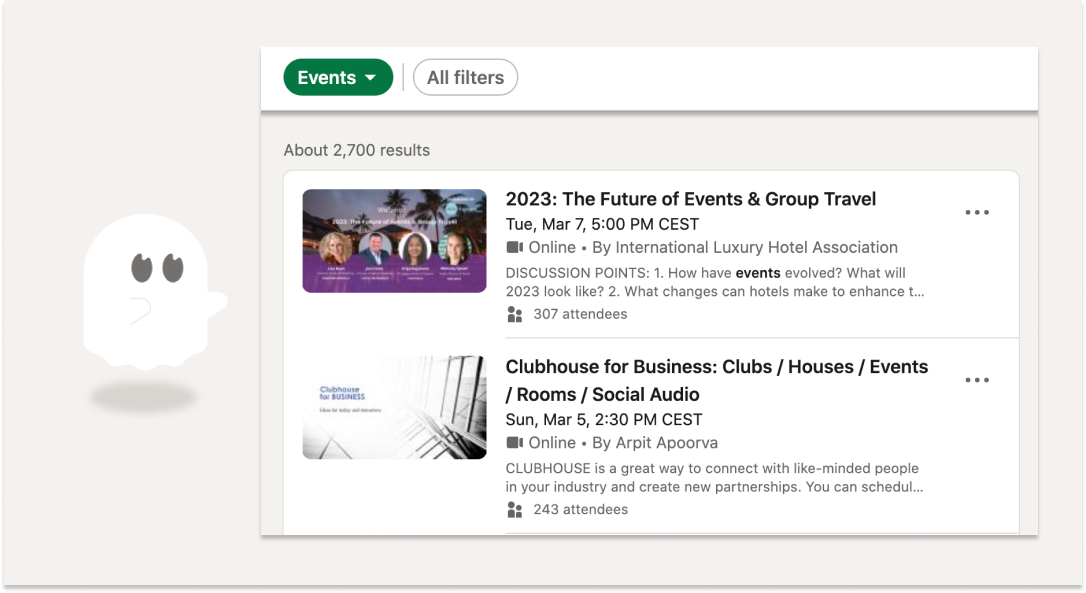
For example, you could use the LinkedIn Event Guests Export Phantom to list all the people who are signed up (aka, your potential customers).
Scrape LinkedIn post commenters
Why does this work? By connecting with commenters from LinkedIn posts, you can join the conversation as it happens, making your lead prospecting far more natural and relevant.
Why start a conversation when it's already happening somewhere else on LinkedIn? It's far more natural to connect with people who have commented on a post instead of appearing out of the blue.
Gather a list of relevant LinkedIn posts, and then take a look at the people who have engaged with them. These commenters could be likely candidates for your LinkedIn prospecting efforts.
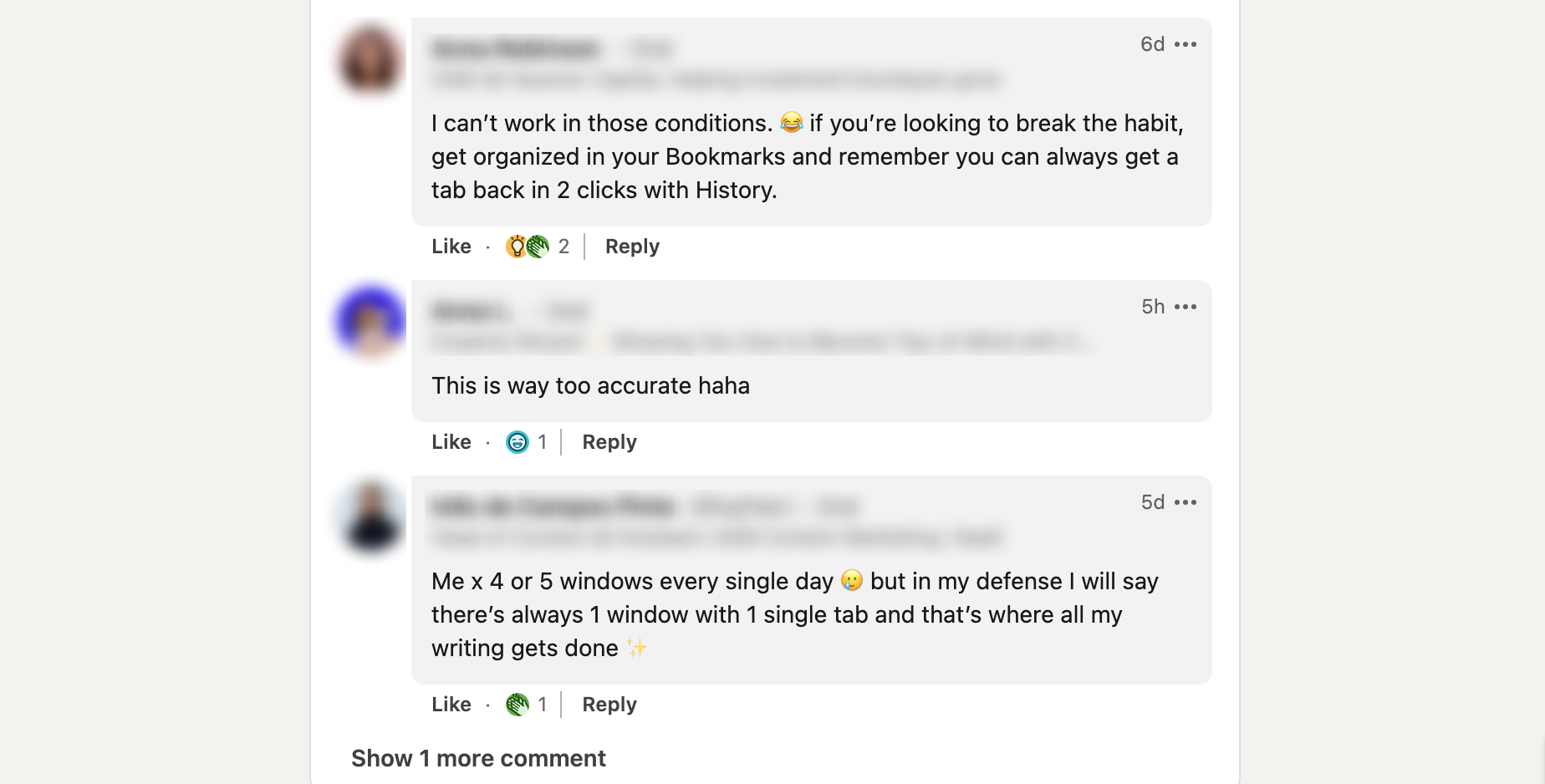
To collect lists of everyone who has commented on a specific post(s), you can use a tool like the LinkedIn Post Commenters Export Phantom to gather them on autopilot.
Once you have your list of LinkedIn profiles, you're free to send connection requests and share hyper-personalized messages about their comments. This makes your entire sales process feel more authentic.
Don't forget about your competitor's network
Why does this work? Connecting with your competitors' followers can be simpler than starting from scratch with someone who is entirely new to the field.
Competitors can actually be an ideal place to find new leads, as these profiles will already have some experience using a similar solution.
For instance, you can check out a company's followers on LinkedIn and connect with them. These people might be more receptive to your business as they already understand the industry.
To find similar companies, use the LinkedIn search engine to filter and identify organizations in your niche.
The more specific, the better!
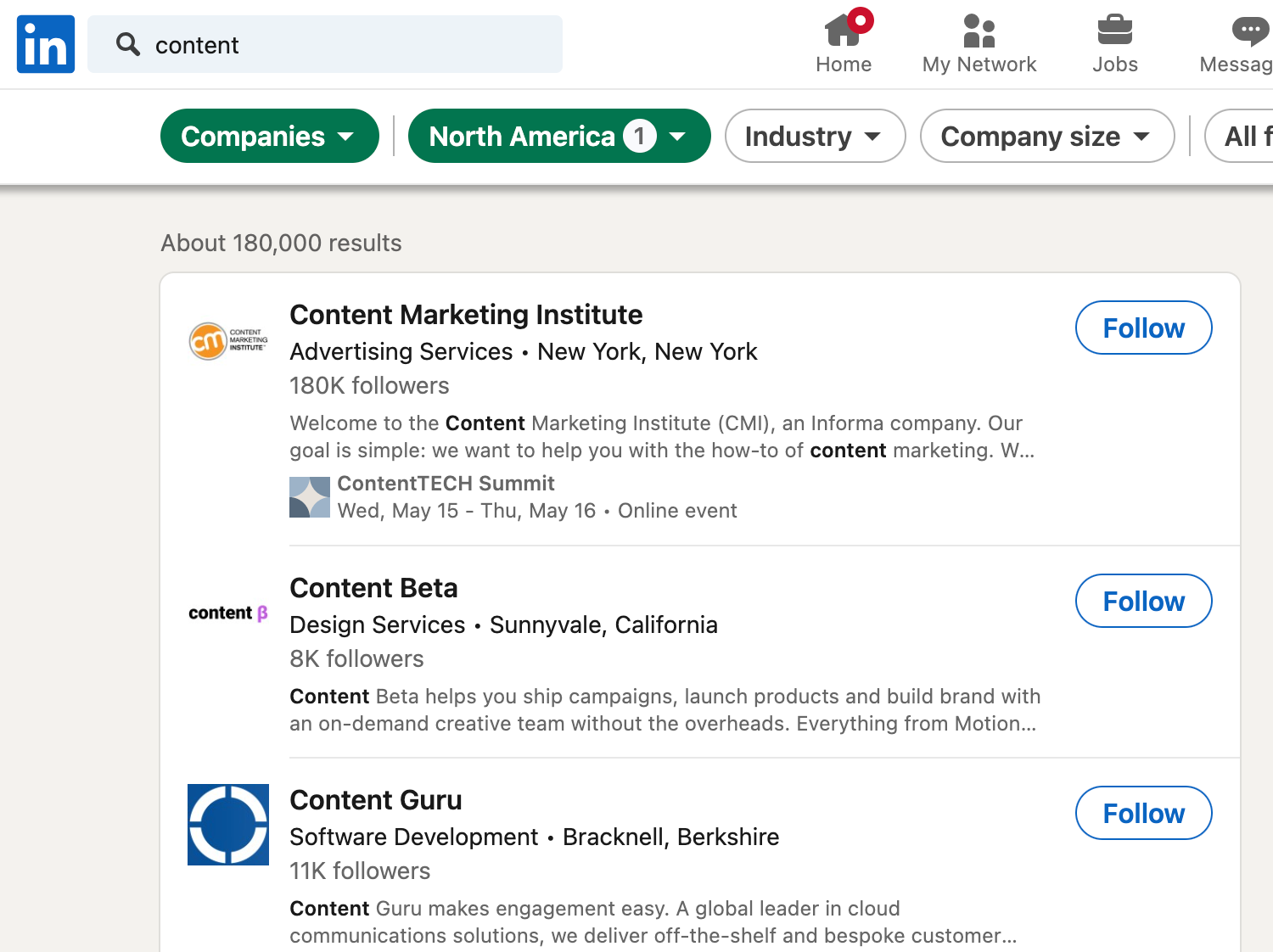
Run an alumni search
Why does this work? Alumni search lets you find common ground, or it can help you to tailor a LinkedIn outreach campaign for people within a certain field or industry.
As the largest professional network in the world, LinkedIn's search alerts and functionalities are unrivaled. Alumni search is a lesser-known function, but it could make all the difference to your LinkedIn prospecting.
Alumni search lets you find relevant profiles who might have attended the same university as you or participated in a program linked to your industry, for example.
Whether you want to find common ground or target a specific group of people, you can visit any university page and select the 'Alumni' tab.
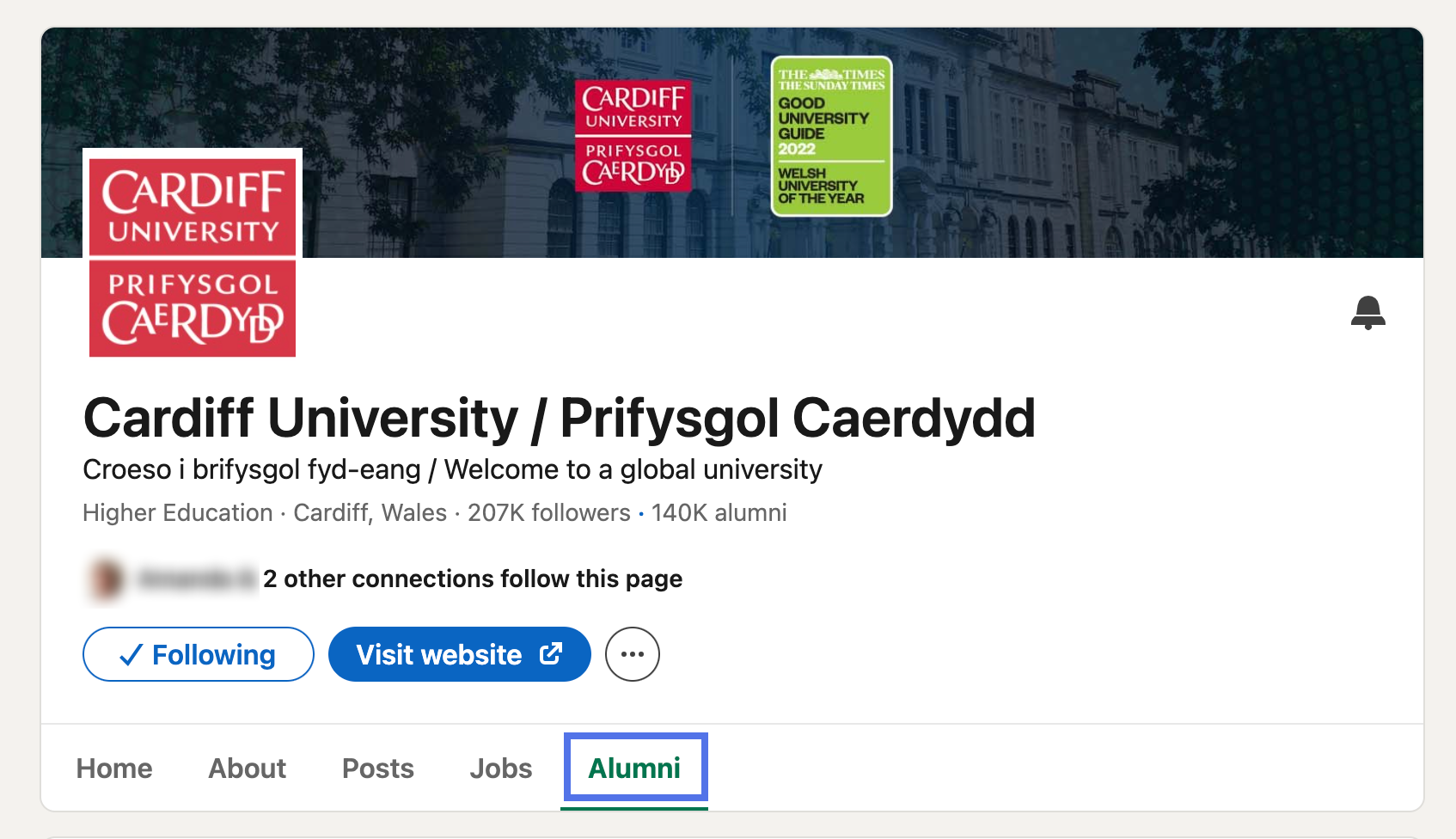
From here, you can filter and search for alumni with certain keywords and time frames. For instance, here are some of the results for sales reps who studied at Cardiff between 1990 and 2024.
These statistics can be useful for market research, and underneath, there's a list of relevant profiles, along with any mutual connections you may have.
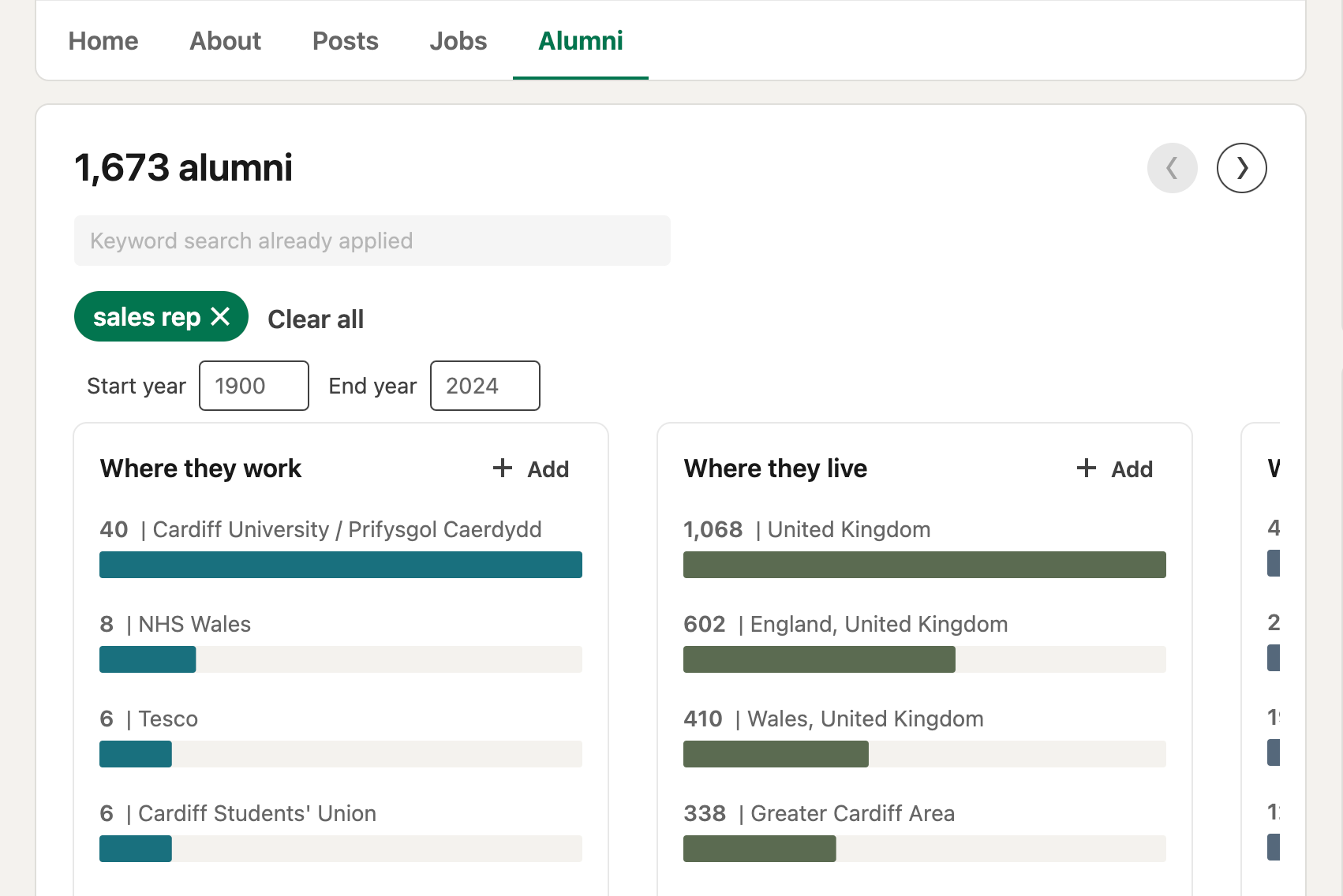
Use LinkedIn Sales Navigator for better search results
Why does this work? LinkedIn Sales Navigator offers more advanced search filters, helping you to find your best LinkedIn leads in less time.
You don't need LinkedIn Sales Navigator to use all these prospecting tips.
However, if you rely heavily on LinkedIn search, then Sales Navigator's advanced filters could bring more refined results.
You can access 30+ Sales Navigator search filters, such as:
-
Company size
-
Profile language
-
Seniority level
-
Exclude contacted/ saved/ viewed leads
-
Following your company
-
Mentioned in the news
Plus, you can save your leads and accounts into Sales Navigator lists.
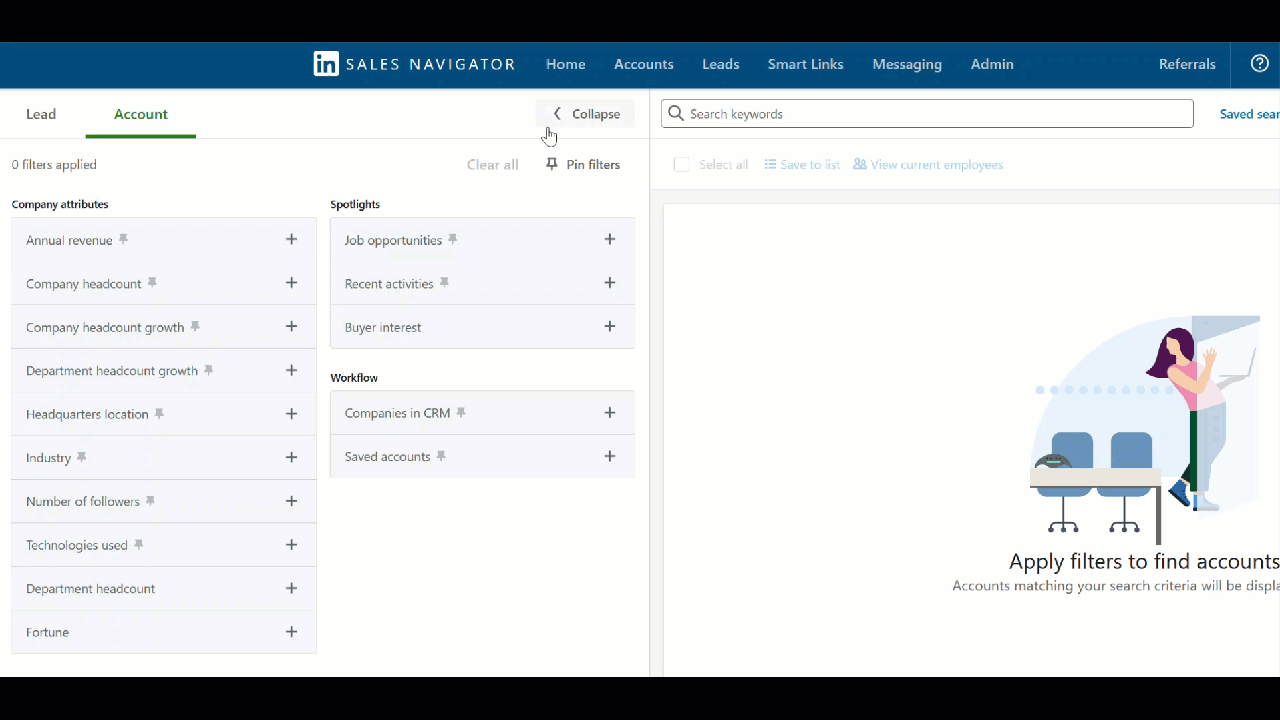
With the right tool, you can then export your Sales Navigator list to a spreadsheet or Google Document.
Here's one way to do it, with a little help from both Sales Navigator and PhantomBuster:
-
Copy the URL of your Sales Navigator leads list.
-
Paste it into the Sales Navigator List Export Phantom setup.
-
Choose your settings, then launch the Phantom.
You can then export your Sales Navigator leads, ready for the next step of your sales prospecting.
LinkedIn prospecting best practices for lead enrichment
Congratulations, you've got your list of leads! But what if you want to know them better?
Whether you want to send personalized connection requests or write a message that resonates, here are 3 LinkedIn prospecting tools to help you get to know your audience inside out.
-
Scrape their LinkedIn profiles
-
Use AI to enrich your lead list
-
Plug the LinkedIn data into your CRM tools
Scrape LinkedIn profiles to get to know your leads
Why does this work? Prospecting on LinkedIn works best when you take the time to really know your audience. This leads to more honest, personalized conversations, and you can use LinkedIn scraper tools to do it in bulk.
Any successful LinkedIn prospecting workflow relies on one thing—personalization!
Take the time to view your prospects' profiles. This will make your outreach efforts more authentic and lead to more conversions later.
Click on any LinkedIn profile to view data such as employment history, job title, location, and interests. Use this data to send personalized LinkedIn messages or to build a clearer picture of your ICP.
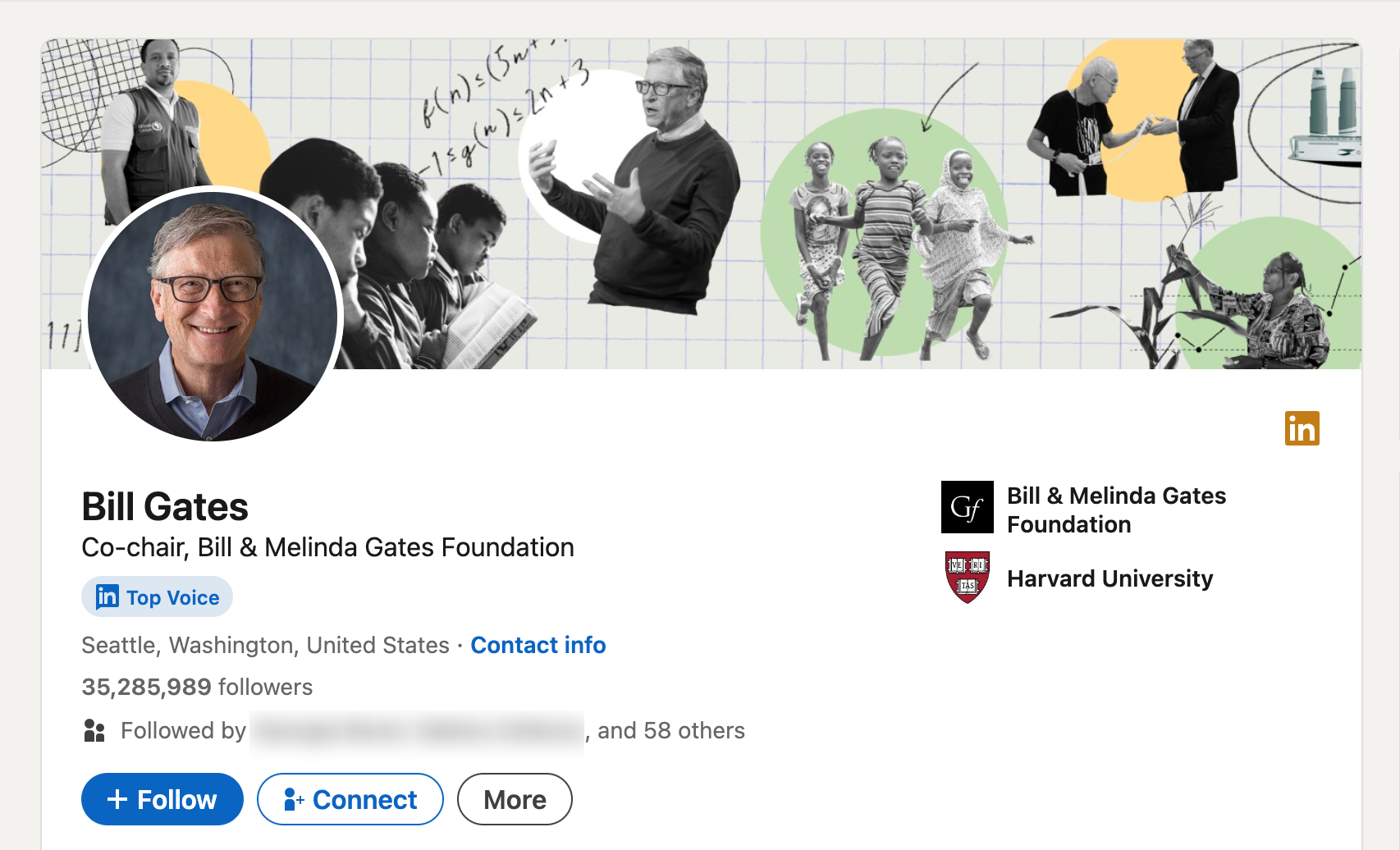
What if you want to analyze LinkedIn profiles in bulk? List them in an open Google Sheet, and then plug the URL into your favorite LinkedIn automation tool, such as PhantomBuster's LinkedIn Profile Scraper Phantom.
You can then automatically export the data from these LinkedIn profiles (and view it straight from your PhantomBuster dashboard, too).
Use AI to enrich your lead list
Why does this work? Juggling lots of confusing LinkedIn profiles at once can be overwhelming. An AI prospecting tool helps you to break through the noise and find clear, actionable insights about your leads.
Whether you love or hate it, artificial intelligence (AI) has taken the world by storm. And it could just be the missing piece in your sales prospecting toolkit.
There are also plenty of AI lead management tools for LinkedIn.
Take PhantomBuster's AI LinkedIn Profile Enricher Phantom, for instance. It takes a list of LinkedIn profiles and then delivers AI-generated data insights for you.
You could use this AI LinkedIn prospecting tool to:
-
Generate lead scores, based on how likely they are to convert
-
Guess what their career goals might be, based on their profile
-
Suggest which outreach channels, such as email or DM, would be most effective
-
Indicate any possible pain points
You'll be able to view your enriched LinkedIn data straight from your PhantomBuster dashboard.
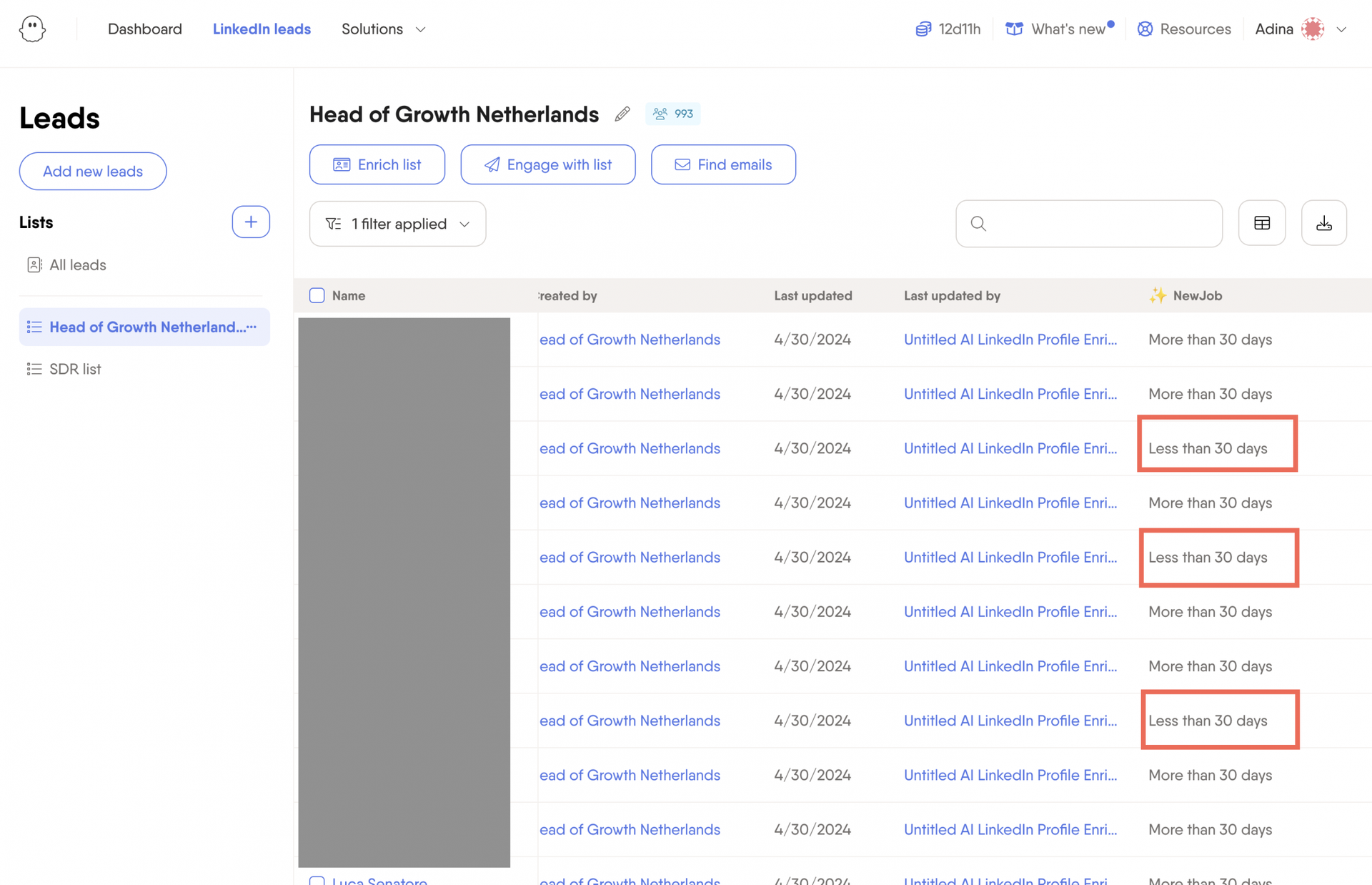
Keep your CRM tools up to date with LinkedIn data
Why does this work? With CRM integrations, you can use your LinkedIn data throughout the rest of your sales prospecting process.
Prospecting on LinkedIn doesn't stop here. Once you've gathered all your enriched data, it's time to plug it into your favorite CRM platform, such as HubSpot.
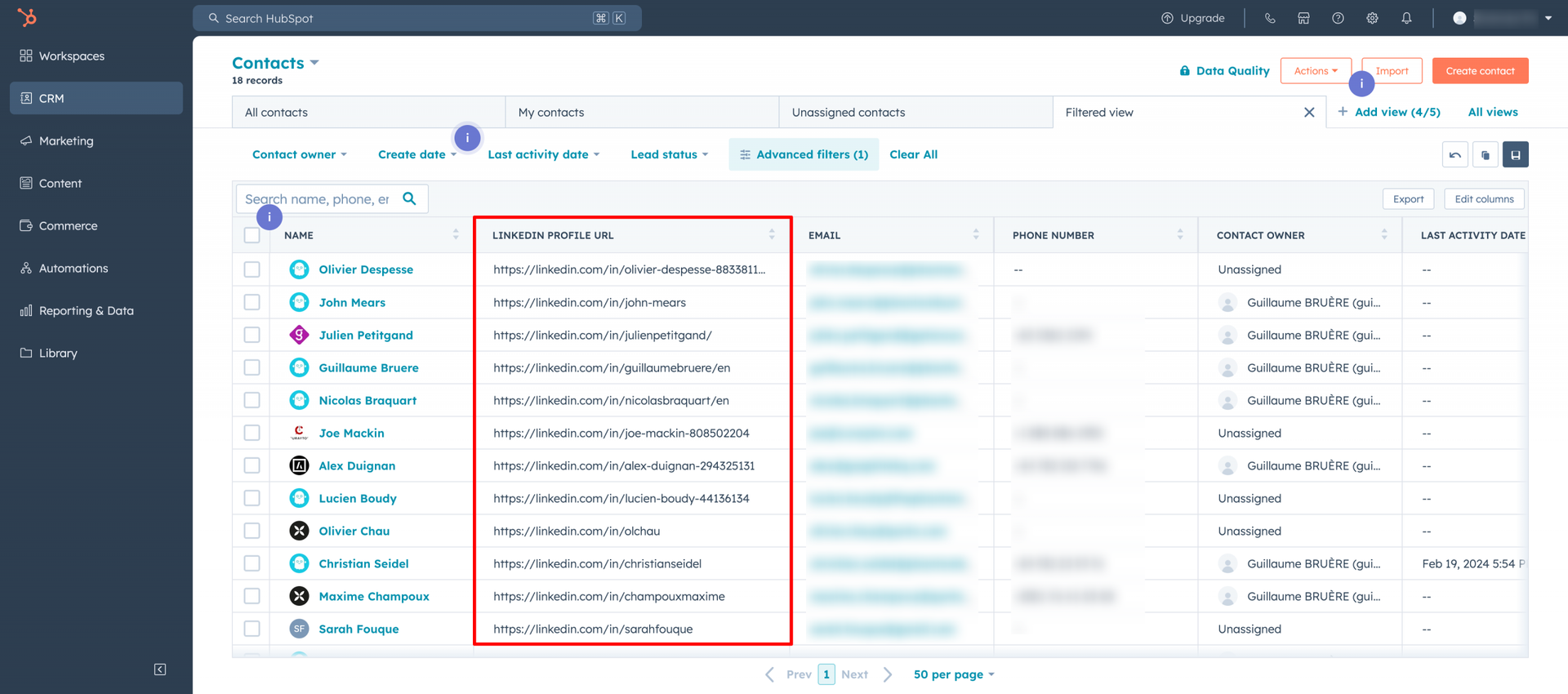
However, manually copying your LinkedIn data into your CRM can drain time. If you want to do it faster, you could use a lead generation automation tool like PhantomBuster.
You can integrate PhantomBuster with your HubSpot account and either:
-
Find someone's LinkedIn profile URL, then add it to HubSpot
-
Gather LinkedIn profile data, then add it to HubSpot
Thanks to CRM data enrichment, your LinkedIn prospecting can work hand-in-hand with your CRM platform on autopilot.
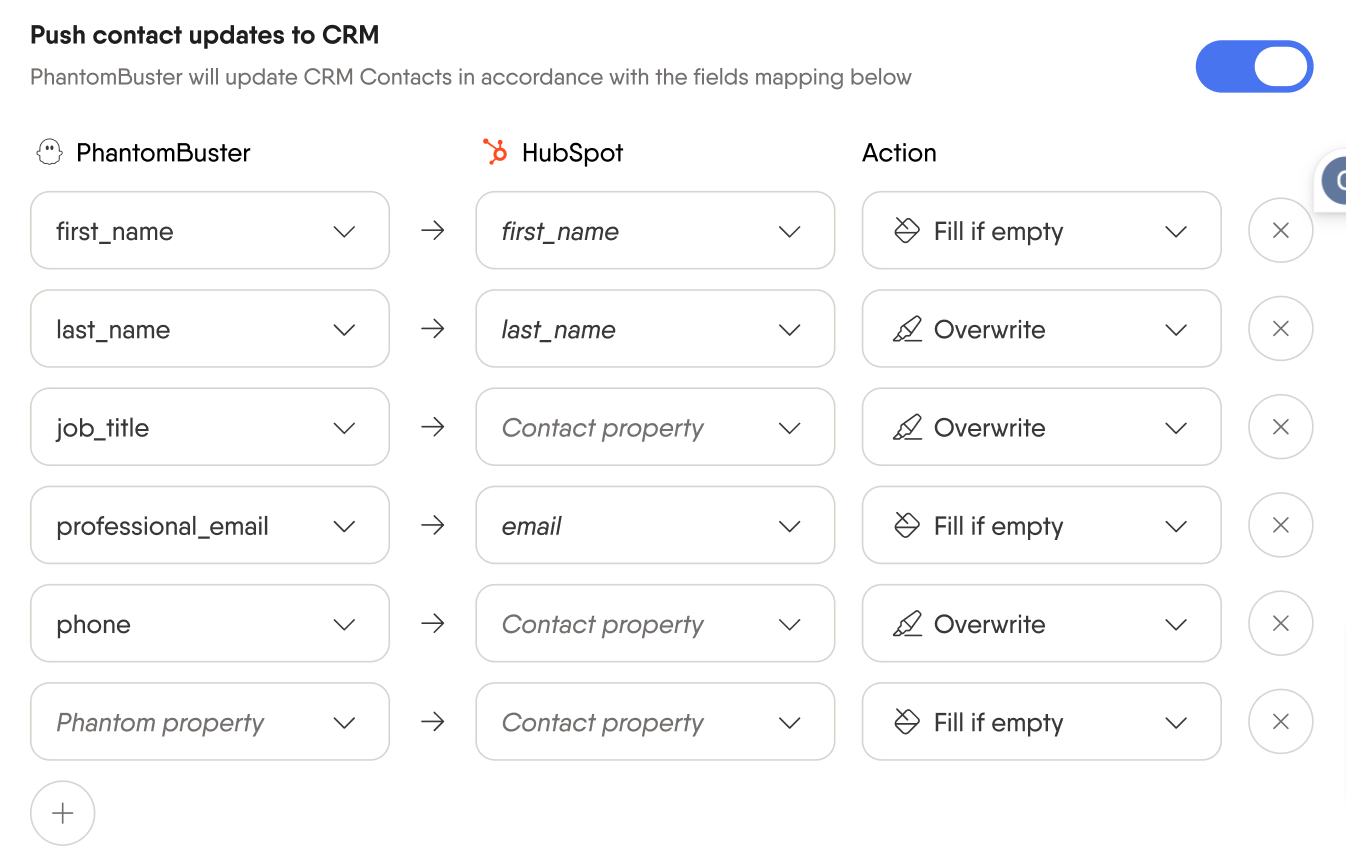
LinkedIn prospecting automation best practices
Once you've gathered and enriched your potential customers, it's time to think about your outreach campaigns.
However, sending a personalized connection request and LinkedIn message to every single lead can be overwhelming.
Here are 7 best practices to automate the process whilst maintaining your unique voice and authenticity.
-
Auto-message people with new roles
-
Warm up your list before messaging them
-
Send personalized connection requests
-
Send free InMails to open profiles
-
Work from multiple LinkedIn accounts
-
Combine the power of LinkedIn prospecting and cold email
-
Stick to LinkedIn's recommended rate limits
Automate LinkedIn outreach messages to prospects with new roles
Why does this work? Automated outreach based on personalized filters lets you reach more people in less time, whilst still sharing messages that resonate.
One of the best LinkedIn outreach methods is congratulating someone on a new role. This sounds far more natural than the traditional "Buy my stuff!" sales prospecting jargon.
For example, with PhantomBuster, you can view your AI-enriched data from the LinkedIn leads page and filter it based on people who have been in a certain role for less than 30 days.
You can then save this filtered data as a new list and use it as input for automated actions, such as the LinkedIn Outreach Flow.

This comprehensive workflow lets you send:
-
Personalized connection requests (e.g. "Congratulations on your new role, would love to hear more about it!")
-
An introductory LinkedIn message to those who accept
-
A maximum of 3 follow-up messages for those who don't reply
⭐️ Bonus tip: You can also send LinkedIn voice messages through the mobile application. However, use this feature with caution! If you're already known to the prospect, then LinkedIn voice messages could be a nice personal touch. But if it's your first interaction, then a voice note might be too intense.
Warm up your lead list before automating outreach campaigns
Why does this work? Based on your previous interactions, the prospect will be more likely to recognize you and respond positively.
Rather than instantly popping up in someone's inbox, it can be better to engage with some of their content first.
You might follow prospects or comment on a few of their posts, for instance. This means that when you send a LinkedIn message, you'll already be a familiar face.
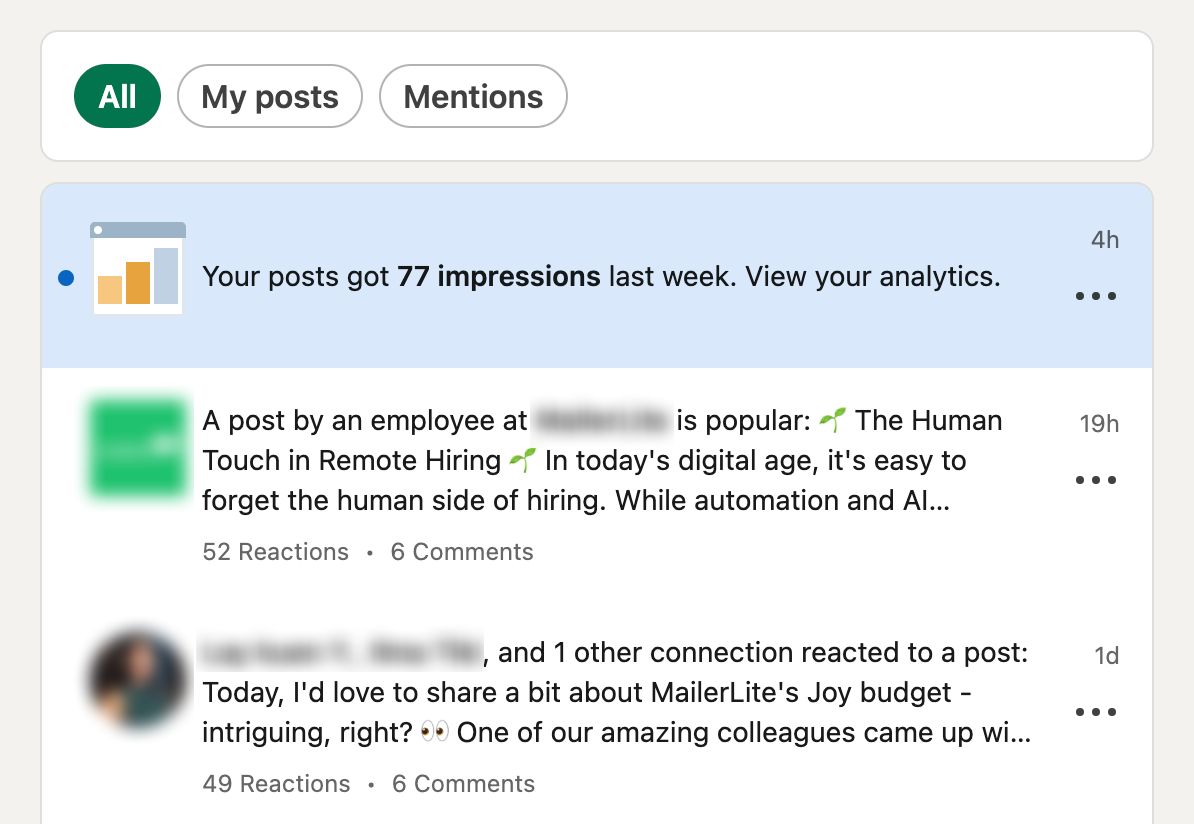
Plus, you can use sales prospecting automation tools to simplify the process. Here are just a few examples:
-
Auto-follow a list of LinkedIn profiles
-
Like a series of LinkedIn posts on autopilot
-
Automatically leave comments on your leads' content
Send personalized connection request messages
Why does this work? Personalized connection requests present a unique opportunity to catch someone's attention and increase their chances of accepting.
Personalized invitation messages are a great way to stand out in someone's notifications and set the tone right away.
But with a limited number of connection requests, you need to make each one count.
If you have a paid account, you can personalize as many connection requests as you like.
However, free accounts are limited to 1-2 personalized connection requests per week.
|
Action |
Free LinkedIn Account Limit |
Paid LinkedIn Account Limit |
|---|---|---|
|
Connection requests |
100/ week |
100/ week |
|
Invitation messages |
1-2/ week |
Unlimited |
Regardless of your plan type, you should make the most of personalized invitation messages. With the right automation tool, you can send these connection requests in just a few clicks.
For example, using the LinkedIn Auto Connect Phantom, you can use a list of profiles you want to connect with and automate invitation messages. You can also use the available data in your list to add placeholder tags and personalize the messages.
These personalization tags are inserted automatically when you launch the automation, sending unique messages to every recipient.
Identify Open Profiles and send them free messages
Why does this work? Contacting Open Profiles lets you reach more people without a paid LinkedIn account or InMail credits.
LinkedIn Premium members can opt to have an 'Open Profile', which means that anyone can contact them and view their full profile, even if they aren't a first-degree connection.
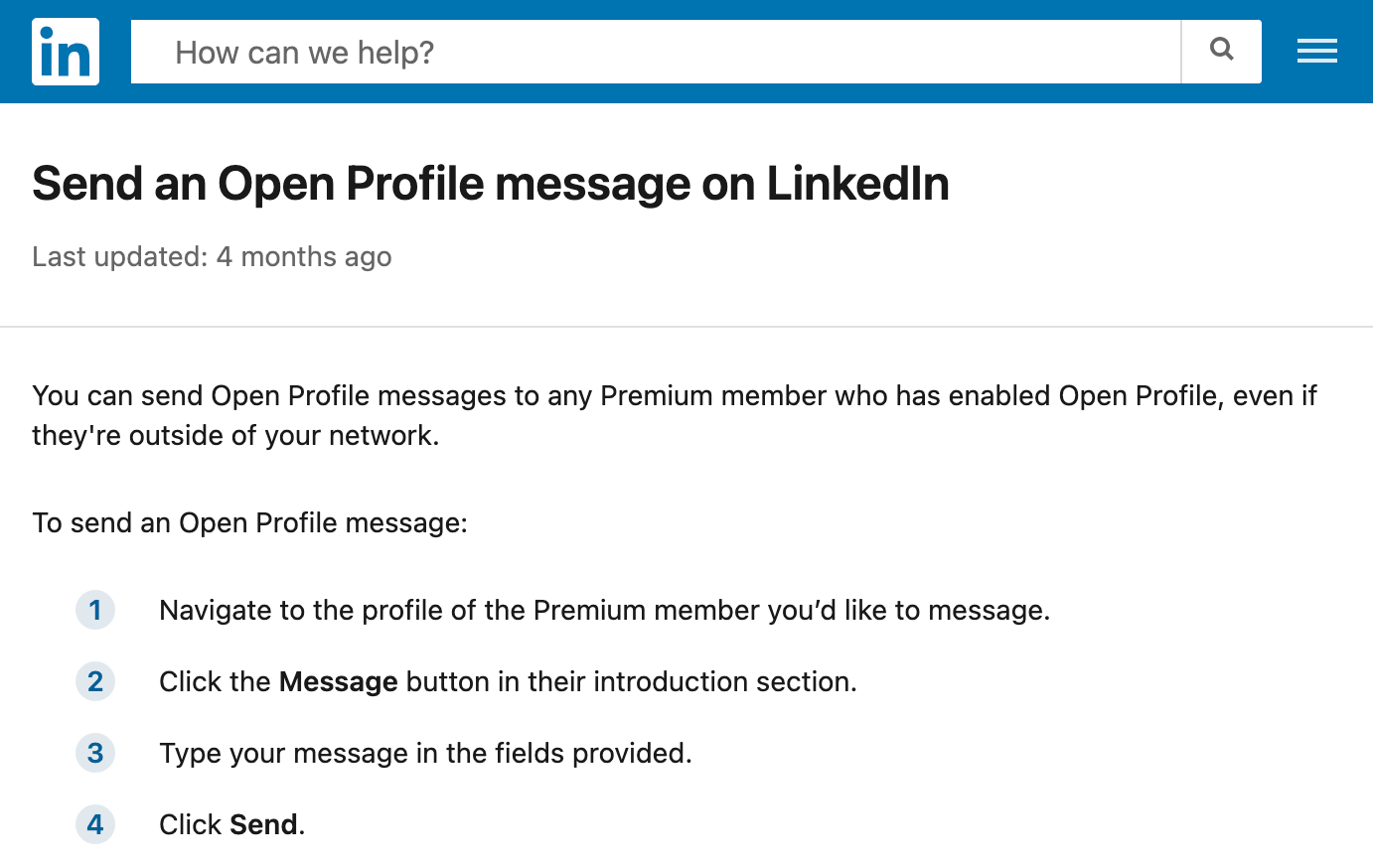
You can enjoy the free messaging without using paid InMail credits or sending connection requests.
While you can't specifically search for Open Profiles on LinkedIn, using a tool like PhantomBuster LinkedIn Profile Scraper, you can extract information about each profile.
Then, filter your lead results and create a separate list based on which prospects have an open profile.
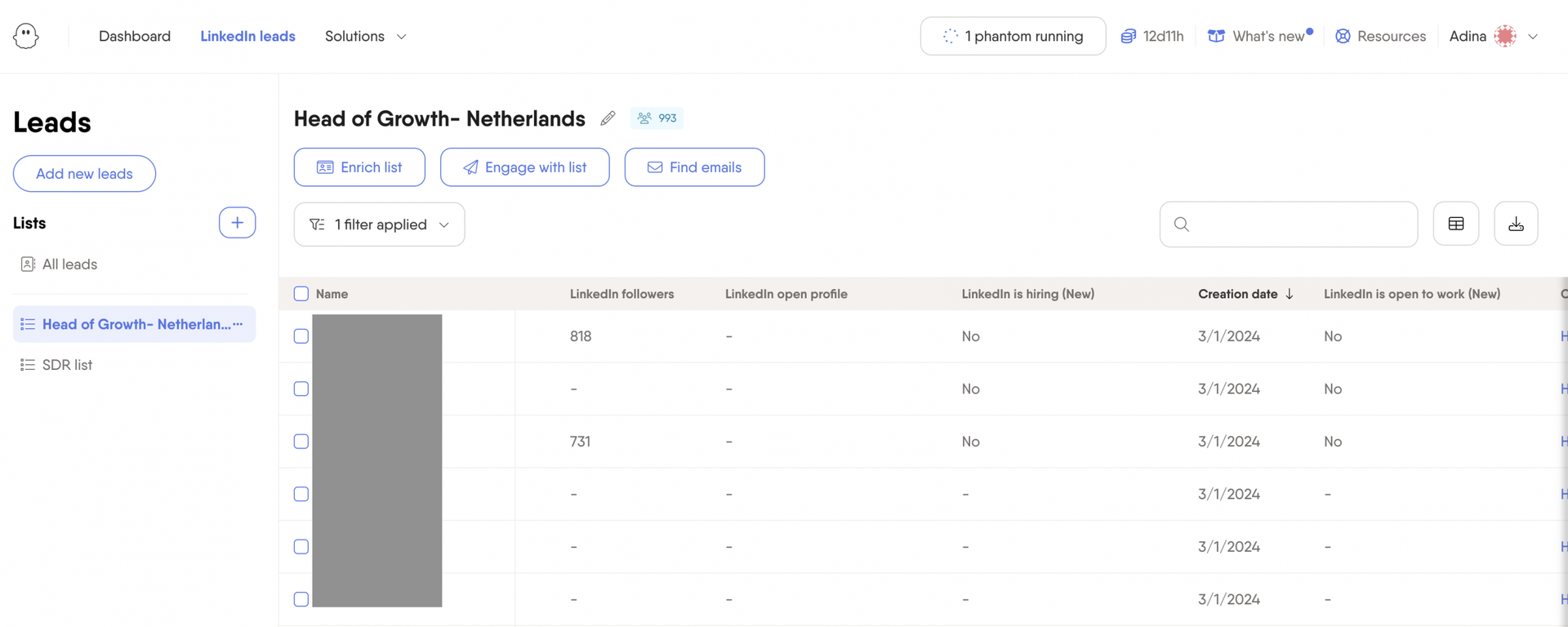
Manage multiple LinkedIn accounts with one tool
Why does this work? Using multiple LinkedIn accounts gives you complete control over multiple automations, helping you to scale your workload over time.
If you automate a lot of your LinkedIn marketing and sales efforts, it could be worthwhile to work via several different accounts. You can run multiple actions at once and increase your reach as you go.
With a PhantomBuster account, you can create a Workspace to run separate workflows for different LinkedIn accounts.
Combine LinkedIn prospecting with cold email
Why does this work? Some leads may prefer email communication instead of DMs. But you can still use LinkedIn to source their emails and kickstart your cold campaign.
Sending LinkedIn messages isn't your only option. You can also use LinkedIn to source relevant profiles and automatically extract and verify email addresses for a cold email campaign.
How? You can find emails from LinkedIn using either the:
-
LinkedIn Search to Emails Flow: Delivers emails straight from a LinkedIn search URL
-
Sales Navigator Search to Emails Flow: Delivers emails straight from a Sales Navigator search URL
Automate LinkedIn prospecting responsibly
Why does this work? By respecting LinkedIn's rate limits, you can grow your outreach steadily and sustainably over time, and protect your account.
Just like speed limits on the road, there are LinkedIn limits to control how many actions you can run from your profile. If you "speed" through these controls, it could affect your account.
When automating on LinkedIn, choose a tool that offers suggestions related to these limits.
The tool should have flexible settings so that you can control how much and how often you automate.
Bear in mind that newer LinkedIn accounts should automate more slowly than established profiles, so there isn't always a "one size fits all" approach here.
LinkedIn prospecting tools
So, how do you know which LinkedIn prospecting tool is right for you? Here are our top choices for automating on LinkedIn, with their main strengths and pricing models to help you decide.
PhantomBuster
PhantomBuster is a LinkedIn automation tool that lets you engage with leads, scrape data, send outreach campaigns, and plug the results into your CRM.
Although it wouldn't be a good fit for people looking for a free account (it only offers a 14-day trial), PhantomBuster lets you:
-
Use pre-built automations to run your lead generation at scale
-
Go beyond LinkedIn with tools for other social media platforms, too
-
Manage multiple LinkedIn accounts
-
Stick to the rate limits with tailored recommendations for each workflow
PhantomBuster pricing
-
Starter: From $56/mo, 20h execution time, AI credits, 5 Phantom slots, unlimited data export, 500 email credits.
-
Pro: From $128/mo, 80h execution time, AI credits, 15 Phantom slots, unlimited data export, 2,500 email credits.
-
Team: From $352/mo, 300h execution time, AI credits, 50 Phantom slots, unlimited data export, 10,000 email credits.
Expandi
Expandi is a LinkedIn automation tool designed for sales teams and agencies. It's particularly beneficial for anyone wanting to grow their professional connections.
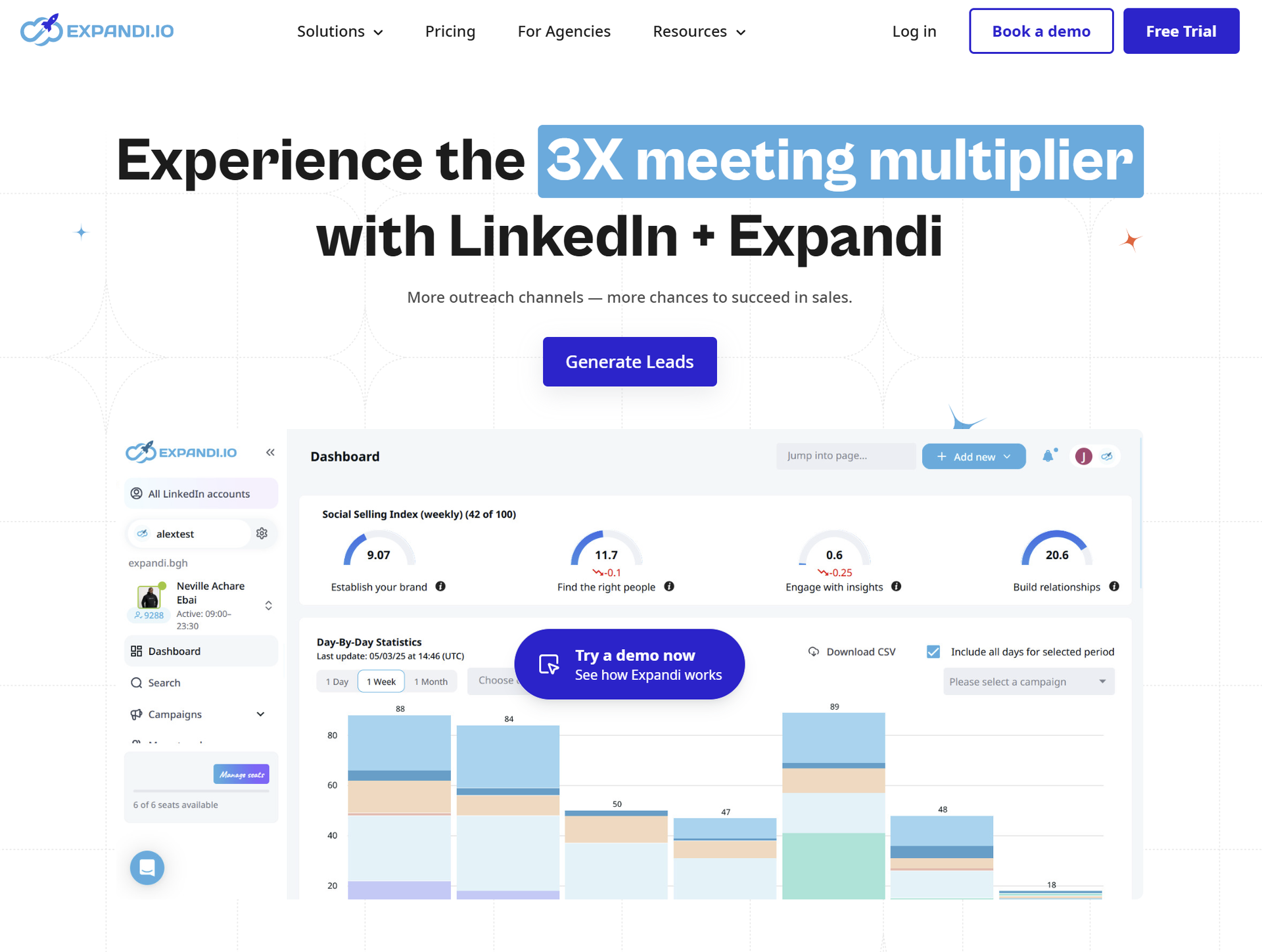
While it has limited personalization features, Expandi still lets you:
-
Use a rapid connection requests system to build your network quickly
-
Benefit from lead management tools to plan your outreach
Expandi pricing
-
Business: $99/month – Access to multiple campaigns and scraping options with a focus on account safety
-
Agency: Custom pricing
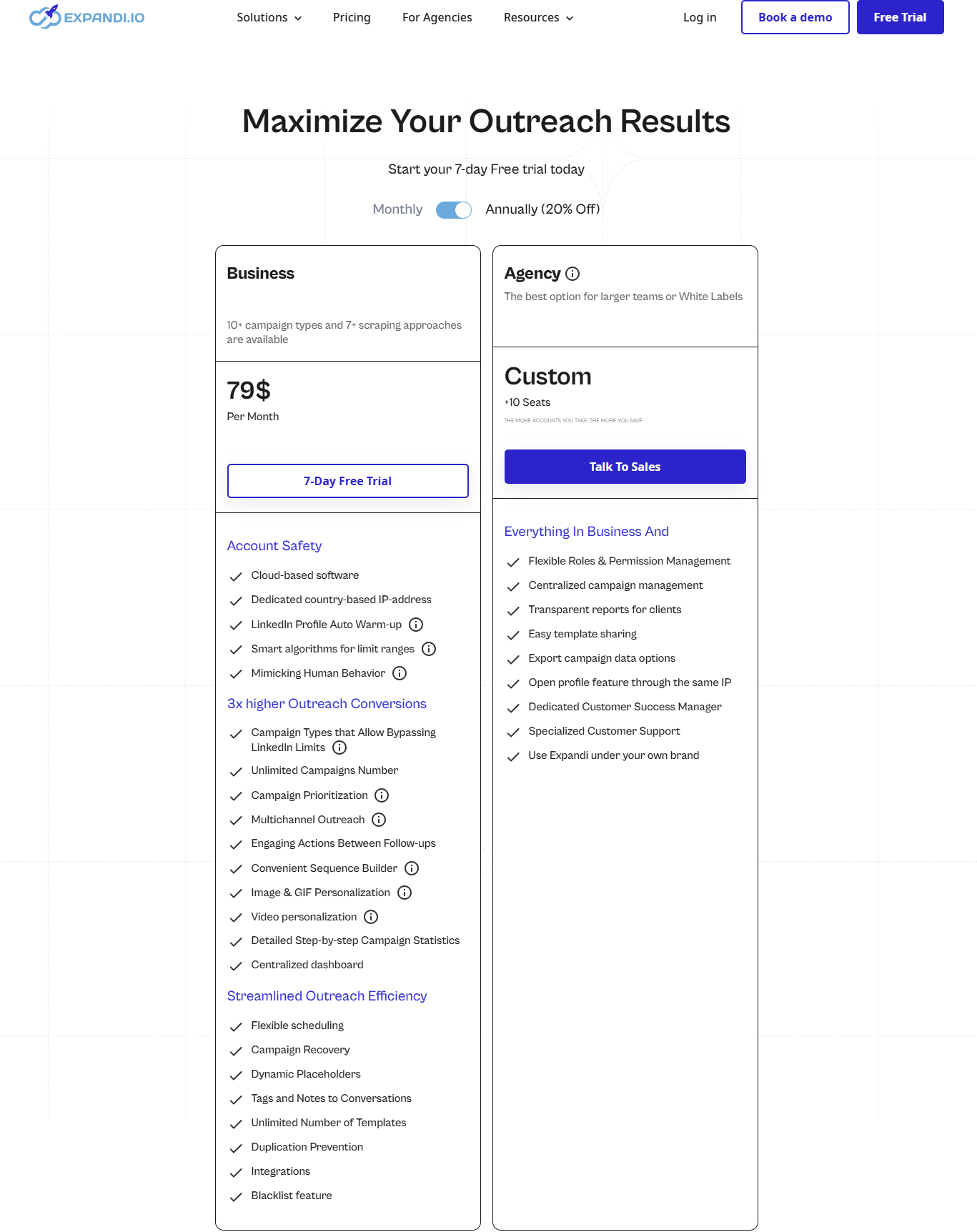
Captain Data
Captain Data is a prospecting tool for operations teams that focuses on data extraction and enrichment. This makes it ideal for anyone wanting to gather data from LinkedIn.
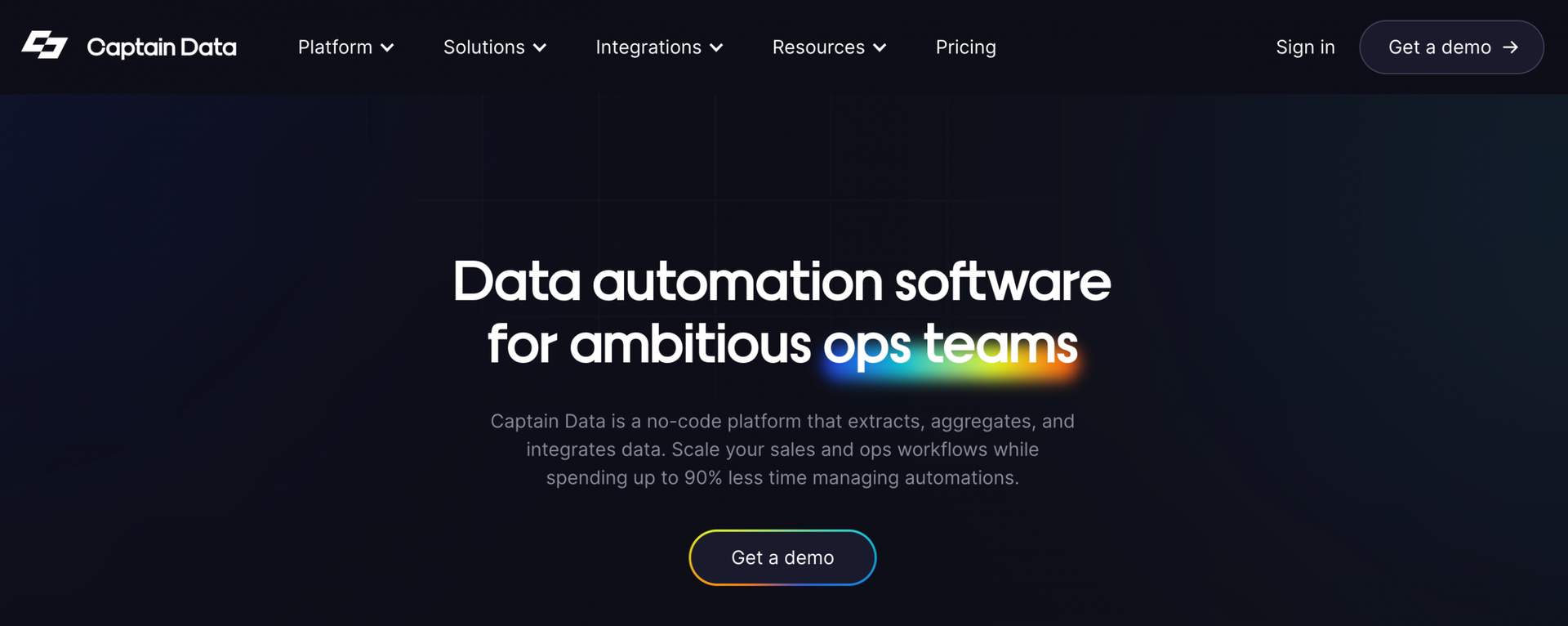
Although it's one of the more expensive tools out there, Captain Data lets you:
-
Enjoy an accessible platform to run LinkedIn actions from
-
Extract high-quality data to help you make the best decisions
Captain Data pricing
-
Trial: $0 for 7 days – Available on request with automated sales ops workflows with 1,000 credits and essential features for team collaboration
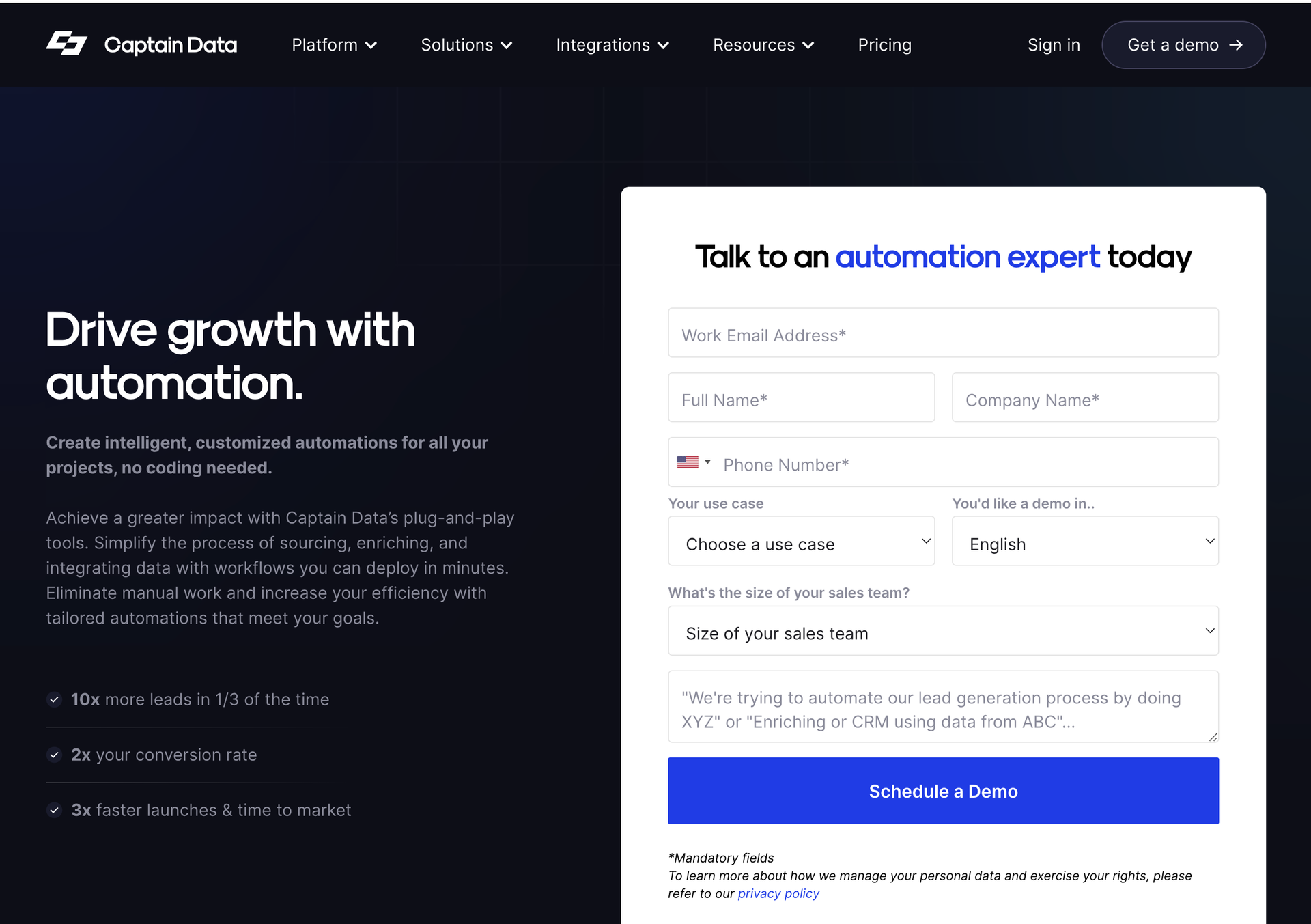
-
Scale: $999/month (billed annually); for growing sales teams, with 50,000 credits per month and CRM integration and account rotation
-
Enterprise: Custom pricing for large teams, offering 250,000 credits per month and advanced options, including on-demand SLAs and custom builds
Dux-Soup
Dux-Soup is a LinkedIn Chrome extension tool that lets you send messages, view profiles, endorse skills, scrape profiles, and more.
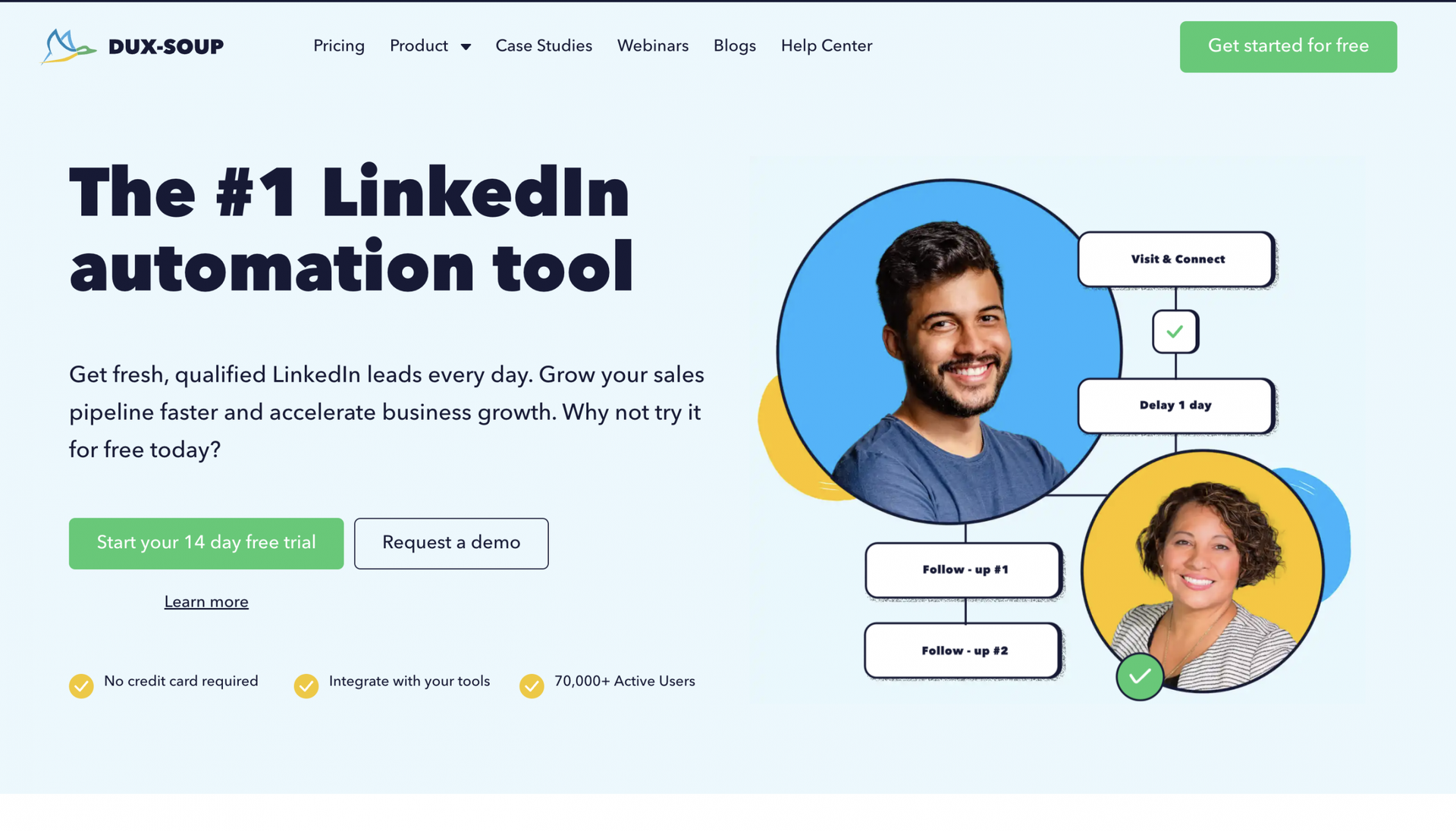
Even though it lacks cloud-based functionality, Dux-Soup lets you:
-
Enjoy a straightforward interface to run your LinkedIn campaigns from
-
Automatically boost your LinkedIn prospecting efforts via the Chrome extension
Dux-Soup pricing
Here's the pricing for an Individual/ Team plan.
-
Pro Dux: €12.99/month/seat— basic automating actions on your LinkedIn account
-
Turbo Dux: €49.00/month/seat – includes multi-touch campaigns for up to 12 actions
-
Cloud Dux: €88.00/month/seat – 24/7 lead gen for teams, fully automated in the cloud
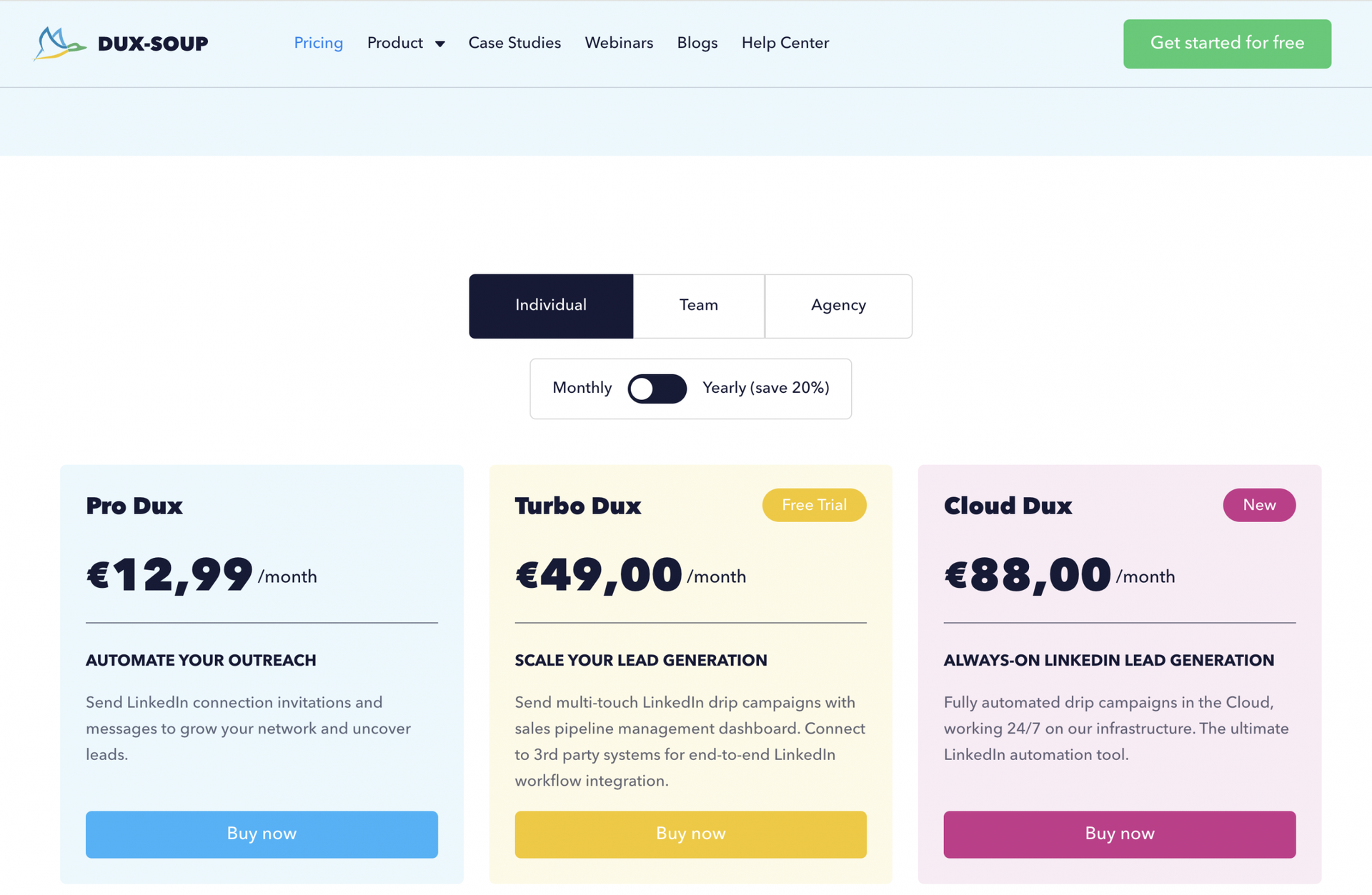
Conclusion
LinkedIn prospecting is an ideal way to connect with decision-makers, find more potential leads, and scale your outreach. And with these best practices and tools at your fingertips, you can streamline the whole process from A to Z.
Remember to tailor your outreach strategy according to your target audience, and try out an automation tool such as PhantomBuster to help you along the way.
